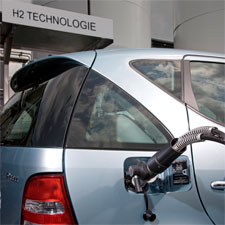Germany Keeps Uptight With Plans Of Hydrogen-Powered Cars
It’s amusing to reduce the introduction of next-generation electric- or hydrogen-powered cars to a binary paper-versus-plastic decision, but the companies making these cars along with the infrastructure to support them are hoping there will be room for both. Hydrogen cars, particularly, have had a bumpy road thus far-the Obama administration is at odds with Congress over if you should fund hydrogen fuel-cell research. Meanwhile, the very first commercial models are not supposed to hit the road until 2015, a few years after their hybrid and all-electric counterparts.
To help steer hydrogen back into the spotlight, carmaker Daimler, AG, teamed together with the German government Wednesday with a press conference hosted in Washington, D.C., from the National Hydrogen Association* to present their case to the continued growth of hydrogen fuel cell cars and the infrastructure to support them.
Public perception of late appear to be that battery-powered vehicles would be the key players in displacing gasoline-dependent internal combustion engines, “”but we believe that hydrogen will also play a role, and that the 2 technologies are complementary,”” Klaus Bonhoff, managing director of Germany’s National Organization Hydrogen and Fuel Cells Technology (NOW), said throughout the event, which Daimler sponsored. The German federal government created NOW, which is largely funded by private sector businesses, to manage hydrogen and other fuel-cell technologies created by the German National Innovation Program (NIP). “”In the public discussion people tend to point out that industry is not interested in hydrogen, but it’s the opposite. Activities are increasing,”” Bonhoff said.
NOW sees hydrogen cars as being a key aspect in the German government’s intends to reduce the nation’s carbon dioxide emissions 80 percent by 2050. One significant step along the way will be for Germans to be driving vehicles that produce no more than 60 grams of carbon dioxide per kilometer by 2030, Bonhoff said, adding that hydrogen-powered cars have the potential to emit as low as 40 grams of CO2 per kilometer. He noted that even highly optimized internal combustion engines usually are not likely to emit less than 110 grams of CO2 per kilometer.
The hydrogen could come from a number of sources, including renewable energy for instance a wind-to-hydrogen system and biofuels. “”Hydrogen is really a commodity in many industries,”” Bonhoff said. “”We have to figure out how to allow it to be available to the transportation industry.””
One of the primary difficulties of introducing for the market an alternative to gas-powered cars-whether powered with a battery or fuel cell-is building up the quantity of new cars on the road while building out a new fueling infrastructure. Hydrogen supplies could possibly be trucked in initially, but eventually pipelines carrying the fuel to filling stations would be required, Bonhoff said.
Maybe the main impediment to success is breaking out of the chicken and egg cycle: Providers of the hydrogen infrastructure want assurances that you will find a lot of hydrogen-powered vehicles on your way, but carmakers cannot sell the cars without having the infrastructure into position. From Daimler’s perspective, “”the fueling infrastructure has not become real on the extent that people have wanted,”” Ron Grasman, Daimler’s manager of fuel-cell vehicles, said at the event. Still, he added how the German government’s stimulus plan is expected to finance new hydrogen filling stations to complement the 4 already located within the country.
Daimler has spent greater than $1.7 billion on hydrogen car technology to date, Grasman said. The company’s entry into this market is the Sprinter, which it plans to make commercially available in 2015. The car has recently gone through several iterations within the last several years as hydrogen fuel-cell technology has been developed. The newest version could go from zero to 100 kilometers in 11.4 seconds, reach a top speed of 170 kilometers each hour, and operate for an estimated 385 kilometers before refueling. Several other car companies, including Ford, General Motors, Toyota and Honda are also targeting this time frame to roll out hydrogen-powered vehicles.
Germany plans to create an infrastructure for hydrogen vehicles over the next seven-to-a decade via a program called H2Mobility. Grasman said the model that the government is developing could, with some effort, function in the U.S. market, as well. The Usa has been a leader in hydrogen fuel-cell development in the past which is in a good position to promote this technology moving forward, he added.
Washington itself is divided on whether or not to commit to hydrogen-powered autos. Usa Department of Energy Secretary Steven Chu said the federal government was cutting funding for hydrogen car development in favour of improved internal combustion engines and plug-in electric hybrids. Chu pointed for the difficulties of producing a hydrogen filling-station infrastructure and building a long-lasting portable fuel cell as a pair of the reasons that hydrogen-powered vehicles would require a backseat to electric vehicles and hybrids. This assessment is at stark contrast with the George W. Bush White House, which had committed $1.2 billion on research and development for hydrogen-powered fuel cells.
In October, however, the Senate voted to restore nearly all the money-about $200 million-that this Obama administration was likely to cut. The tug-of-war continues, as the White House’s fiscal 2011 budget request would slash funding for hydrogen fuel cells and biofuels.
“”We’ve enjoyed a very hard year in the automobile industry, and it also might seem like there hasn’t been much work in fuel cells,”” Grasman acknowledged. Still, none of the major carmakers have given up their hydrogen programs, because they understand that there is no single solution for replacing internal combustion engines, he added, saying that the plug-in electric car will be a “”niche vehicle,”” whereas hydrogen-powered cars can travel greater distances and refuel faster.
* Editor’s Note: The National Hydrogen Association is section of the Partnership for Advancing the Transition to Hydrogen.



0